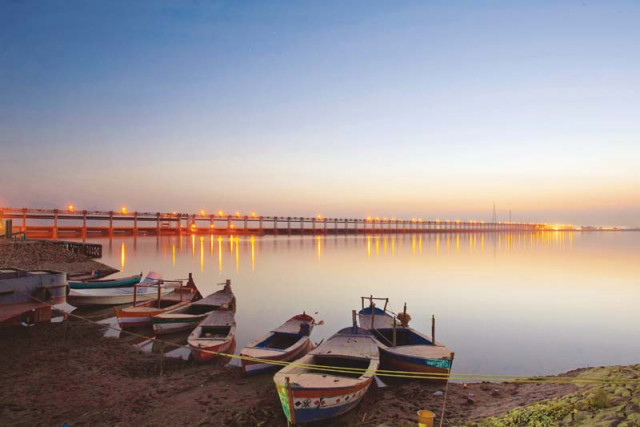In the deep end
The population of Indus River dolphins is sharply declining and may soon entirely disappear from our waters

Taunsa Barrage. PHOTO COURTESY: WWF-PAKISTAN
The Indus River dolphin (Platanista gangetica minor), locally known as bhulan, is a side-swimming mammal found in the Indus River. It is also known as the ‘blind dolphin’ as it doesn’t have a crystalline eye lens, an adaptation mechanism that enables it to survive in murky waters. However, it has a fully developed echolocation mechanism to sense its surroundings and identify prey and potential threats. Experts believe the population of the Indus River dolphin has decreased substantially owing to human-led activities. According to Uzma Khan, director biodiversity at WWF-Pakistan, “The Indus blind dolphin faces multiple threats including overfishing, fish poisoning, increased use of illegal nets, deforestation along the Indus deteriorating the dolphin’s habitat, fragmentation of the river due to dams and barrages, lack of freshwater, agro-industrial pollution and extensive agriculture.” Additionally, the chief conservator of the Sindh Wildlife Department, Javed Ahmed Mehar, says, “illegal nets and fish poisoning are the biggest threats to Indus river dolphin today.” He emphasises the need to promote sustainable fishing practices in order to ensure long-term conservation of Indus River dolphins in Pakistan.

Sindh Wildlife department rescued a dolphin on April 7, 2015. PHOTO COURTESY: WWF-PAKISTAN
The Indus River dolphin was even hunted in the past as people extracted oil from its body parts for medicinal purposes. Today, barrages have restricted the dolphins’ habitat, as water scarcity and low flow affect the creature’s free movement from downstream to upstream of the barrage. An increasing number of threats have confined the dolphin to the main channel only. Presently, the Guddu and Sukkur barrages host the largest population of Indus River dolphins. Therefore, in 1974 the government of Sindh issued a notification designating these areas as “protected areas”. This 200 kilometre stretch is also known as the Indus Dolphin Game Reserve.
WWF-Pakistan, in collaboration with the Sindh Wildlife Department (SWD), is actively engaged in rescuing dolphins stranded in canals and releasing them back into the main stream. Communities are sensitised to report stranded dolphins so they can be rescued before it is too late. Since the 1990s, WWF-Pakistan and SWD have rescued 116 dolphins. In 2014, with the help of local communities, three stranded dolphins were saved and released into the mainstream. On April 7, 2015, WWF-Pakistan and SWD jointly rescued a male dolphin stranded in Patt Feeder Canal, Guddu Barrage, through the help of locals. The dolphin was later released in the mainstream of the Indus River, downstream of Guddu Barrage.
Estimating the population of the Indus River dolphin at an interval of five years is of great importance to streamlining conservation management initiatives. WWF-Pakistan has so far conducted three comprehensive surveys in 2001, 2006 and in 2011. The study conducted in 2001, led by Gillian T Braulik, revealed about 1,200 dolphins exist in the Indus River between Jinnah and Kotri barrages. This was followed by the 2006 and 2011 studies, both supervised by Braulik, which revealed a total abundance of 1,442 dolphins and 1,452 dolphins, respectively. Furthermore, the 2011 study revealed two distinct river sections with maximum dolphin population: Taunsa-Guddu and Guddu-Sukkur river sections holding 91% of the dolphin population found in the Indus River. As a result, Uzma Noureen, coordinator of the 2004 Indus River Dolphin Conservation Project, which aims to conserve the biological diversity of the Indus River, ensure the sustainable use of natural resources and find ways to curb pollution, says, “The area between Taunsa and Guddu which represents the second largest population of Indus River dolphin needs to be declared a legally protected area for dolphins.”

WWF-Pakistan rescues stranded dolphins trapped in canals. PHOTO CREDIT:FRANCOIS XAVIER PELLETIER
WWF-Pakistan through another project titled Improving livelihoods of fishermen communities of Central Indus Wetlands Complex through Effective Natural Resource Management is empowering fisher communities to promote conservation by establishing community-based organisations (CBO) in the area. With 10 CBOs established in Sindh and Punjab, the message of conservation has spread among local communities who now value the biodiversity of the region. One of the CBOs, Indus Welfare Foundation (IWF), established on the west bank of Taunsa Barrage, is raising awareness among communities to reduce their dependence on natural resources and conserve the Indus River dolphin. The president of IWF, Javed Iqbal, says communities are sensitised to protect the endangered dolphin by all means, as it is a source of livelihood and helps promote tourism and other job opportunities.
Mortality rate
Between 1992 and 2010, the dolphin mortality rate was zero to two dolphins per year. In 2011, however, around 28 dolphins were reported dead due to over-fishing and fish poisoning.
SOURCE: Sindh Wildlife department and WWF-Pakistan
Syed Muhammad Abubakar is a freelance journalist and tweets
@SyedMAbubakar
Published in The Express Tribune, Sunday Magazine, July 12th, 2015.



















COMMENTS
Comments are moderated and generally will be posted if they are on-topic and not abusive.
For more information, please see our Comments FAQ